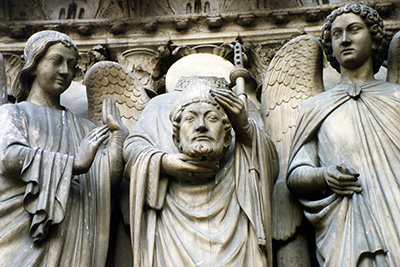The Christianization of Paris
James H.S.McGregor, Paris from the Ground Up (Cambridge, Mass.: Harvard University Press, 2009), pp.22-25.
Statue of St. Denis in the Facade of Notre Dame |
Julian, known to history as the Apostate, was the last Roman emperor to encourage the worship of the Roman state gods. Before the end of the fourth century, the emperor Theodosius I proclaimed Christianity the official religion of the empire. In support of his choice, he banned the sacrifices and cults that had been the cornerstone of Roman devotion. The consequences of this conversion were soon felt in the creation of a religious hierarchy that mimicked the secular bureaucracy governing the Roman Empire. Gaul was divided into a series of episcopal dioceses with a bishop in charge of each. These bishoprics, laid out in the fifth century, persisted more or less unchanged until the French Revolution. When the Roman Empire dissolved and its remains were parceled among Germanic invaders, the dioceses and their leadership remained intact. In many parts of the empire, the church, cloned on the imperial administration , took over the day-to-day rule of provinces that had no other political organization . . . .
Paris already had a Christian population at the time of the empire's official conversion. According to Catholic tradition , in 250 AD Pope Fabianus sent six carefully chosen bishops into Gaul to found new churches and to give organizational help to the Christian communities scattered throughout the region. A religious leader somewhat improbably named Dionysius, after the Greco-Roman god of wine, was sent to Paris, along with two companions, Eleutherius and Rusticus. Nothing definite is known about the work the three did in the city. All that their legend records is a bizarre and dramatic martyrdom.
When certain pagans revealed the trio 's identity to the authorities, the men were arrested and tortured . After enduring extremes of cruelty, they were beheaded. Some accounts place their martyrdom on the lie de la Cite. The more commonly accepted story makes Montmartre -- its name means the Mount of Martyrs -- the scene. Wherever the martyrdom took place, its most noteworthy feature occurred after the head of Dionysius, who in French is called Saint Denis, had been struck off. With a fountain of blood surging up from his neck, the martyr bent down and picked up his own head. Cradling it in his arms, face foremost, the saint began to walk. And as he walked to his chosen place of burial, the head delivered a lengthy sermon. Over time a great shrine and church dedicated to Saint Denis rose on the site where the martyr finally came to rest, on the north side of the city.
Sometime after the conversion of the empire in the fourth century, the city and its bishop were provided with an official Christian worship center. The 1847
Léon Bonnat, The Martyrdom of St Denis (1885) in the Pantheon |
excavations under the pavement directly in front of Notre Dame cathedral uncovered foundations of the kind of building that was typically created in the Roman empire to house Christian worship. While there may have been earlier worship centers in private homes or nearby warehouses, no evidence of them has been found. In fact, there is little evidence of any sort of religious practice in the city during the antique and late antique periods. And with the exception of the temple of the Capitoline trio in the open space of the forum, no other place of worship , either pagan or Christian, has ever come to light.
The foundations of the Christian building discovered in 1847 suggest that it was of substantial size. The portion excavated (none of which is visible to the public at the archaeological site, sadly) is more than a hundred feet long and nearly as wide . Apparently it was a five-aisled basilica with a narrow porch or narthex on its front. The central aisle -- the nave -- was about thirty feet wide. A colonnade at each of its long sides would have supported a high wall with windows that lit the interior. Between each nave colonnade and the outside wall were two aisles separated by a second row of columns. The roof of these aisles would have been lower than the windows that lit the nave. The two aisles would have been lit by windows in the low outside wall . On the south side of the basilica, this outer wall was built over or into the rampart. Some archaeologists have guessed that the basilica incorporated fortifications of its own.
The two basilicas that have been excavated on the island -- this one for Christian worship and the earlier one for administration -- are a wonderful representation of the rough-and-ready adaptations the empire made as official worship shifted from the ancient Roman gods to the God of Christianity. The small temple isolated in the open plaza of the forum suited the worship of the old gods. Christian worship, by contrast , required that the congregation participate in a ritualized meal-the Eucharist-that exemplified the central mystery of the religion . Christians needed room to assemble, and they needed to hear the words of the mass that sanctified the sacrifice. Roman temples were not suited to this task, and even if they had been, the political situation during the early years of Christian toleration put these venerable structures off limits for the new religion. Among the Roman repertoire of building types, the one best suited for Christian worship was the basilica. It carried no religious connotation for the Romans, so its adaptation was not unsettling to either side. It provided shelter for large numbers of people, and its apse was designed to amplify the voice. The celebrant of the mass and the choir used the apse to make themselves heard, just as Roman secular authorities had done.

